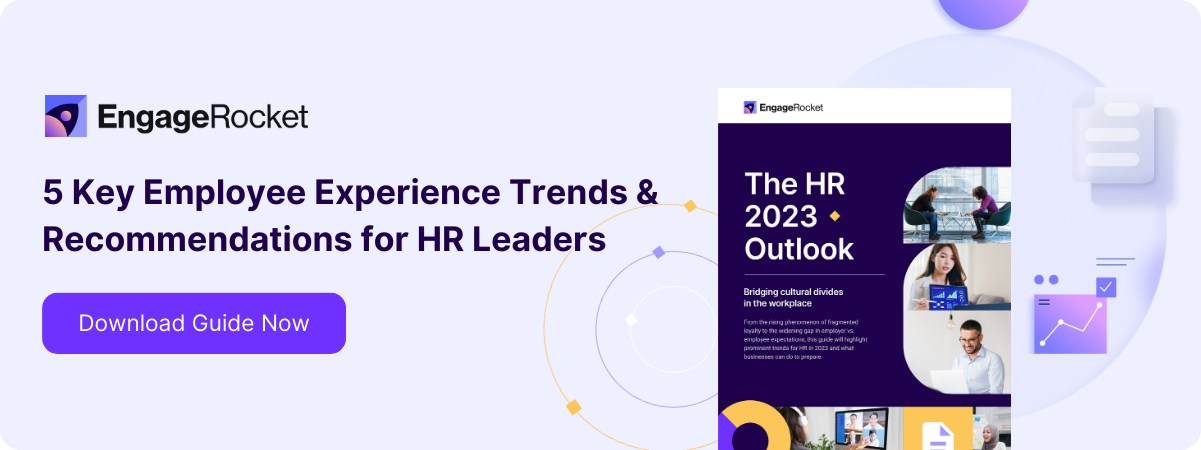Phenomenon like Quiet Quitting and the Great Resignation can be boiled down to a key fundamental problem in the workplace.
In our recently published HR 2023 Outlook, we covered why there's a widening gap between what employers want and what workers need is a common occurrence for most organizations. Both employers and workers are aware of this disconnect, yet few know how to navigate it successfully.
Quiet Quitting is the latest workplace buzzword everybody is talking about. But behind the trend, the crisis seems real, with at least 50% of the U.S. workforce identified as "Quiet quitters" - mostly among younger generations. Many have cited that this phenomenon is nothing new, just an old behavior with a new name.
On the opposite spectrum on 'Quiet Quitting', we have the loud 'Great Resignation', in which skilled workers around the globe leave their jobs for different organizations or, sometimes, different career paths altogether. PwC’s 2022 report found that 1 in 5 workers look to change jobs in the next 12 months, implying that the Great Resignation is far from over.
Although different terms have been coined, ultimately these are symptoms of disengagement that are only the tip of the iceberg. Rather, organizations need to uncover the reasons behind disengagement in the context of their own workplace.
“The Great Resignation and quiet quitting are two consecutive phases and are different behaviors, but actually boils down to the same cause. These two phenomena are caused by disengagement at its core.”
Dr Yvonne Tan
Lead People Scientist at EngageRocket
Why the disengagement is becoming more prominent
In the last two to three years, the disconnect between employee and employer has become more prominent and even taken on new dimensions.
With how fragmented workplaces have become, it's understandable why disengagement is on the rise as well. People are not feeling connected to their organizations and may even feel detached from the 'big picture' of the business.
The causes for disengagement will vary from one organization to another, and even between different cohorts in the same organization.
Traditionally, managers and HR teams have relied on gut instinct when it comes to designing employee experiences – but research shows that this could cause a sizable divide.
For example, a US survey found that 68% of employers are confident that they have invested heavily in their well-being value proposition, but just 51% of employees agree. By relying on gut feeling, organizations risk missing out on solving for the real causes of discontent and disengagement that employees face in the workplace.
What HR and leaders can do to address disengagement
It's important to be close to the ground and understand the general sentiment for disengagement.
Regular conversations with employees and rethinking job design for the younger generation are essential in helping them to find their purpose and satisfaction with their job. What worked 2 years ago may not work anymore - and it's important for leaders to keep this in mind.
“In the current world where hybrid working is the norm, it’s important for leaders to make intentional efforts to draw closer team bonds and help members share what they are doing and how they are feeling about work.”
Mich Goh
Head of Public Policy at Airbnb
Our people scientists have 3 key advices for leaders looking to tackle disengagement in their workplace:
Offer a reason to stay engaged through purpose-driven culture
Invest in ‘benefits’ that go beyond transactional nature. These may be done through actions such as team building exercises, guiding managers to be mentors, and focusing on building a safe, cohesive culture that centers around a shared organizational mission.
Help managers step up as leaders
Provide managers and leaders with the training they need to detect disengagement and stem it at the grassroots level. Give guidance on how managers can better nurture their team members and keep them engaged.
This may be done through providing one-on-one conversation frameworks, guiding them to identify and have meaningful conversations about mental health issues at work, and having a clear leadership framework that managers can refer to at all times.
Conduct regular feedback collection programs
We cannot stress this enough: actions taken to address disengagement need to be based on real data collected from employee feedback, and not gut instinct.
Two such examples of common feedback collection programs are employee experience surveys (EES) to understand sentiment and 360-degree reviews for employee capability and leadership growth.
💡 Read the full highlights or trends and recommendations for the year ahead in the HR 2023 Outlook below:
About the Author

Marie Le Bras is the VP of Marketing at EngageRocket. With more than 10 years of experience, she has helped many startups and businesses see long-term success in their marketing efforts. She's also a proud working mother passionate about leadership, PR strategy and communication.




 .
. 